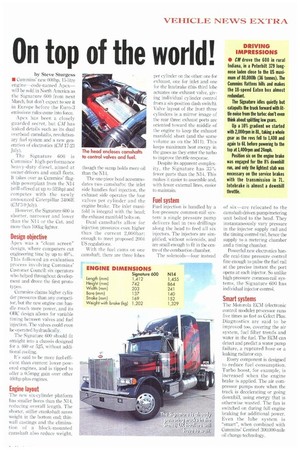On top of the world!
Page 17

If you've noticed an error in this article please click here to report it so we can fix it.
by Steve Sturgess
• Cummins new 600hp, 15-litre engine—code-named Apex— will be sold in North America as the Signature 600 from next March, but don't expect to see it in Europe before the Euro-3 emissions rules come into force.
Apex has been a closely guarded secret, but CM has leaked details such as its dual overhead camshafts, revolutionary fuel system and a new generation of electronics (CM 17-23 July).
The Signature 600 is Cummins' high-performance heavy-duty diesel, aimed at owner-drivers and small fleets. It takes over as Cummins' flagship powerplant from the N14 (still offered at up to 525hp) and competes with the newly announced Caterpillar 3406E (CM 3-9 July).
However, the Signature 600 is shorter, narrower and lower than the N14 or the Cat. and more than 100kg lighter.
Apex was a "clean screen" design, where computers cut engineering time by up to 10%. This followed an evaluation process involving Cummins' Customer Council: six operators who helped throughout development and drove the first prototypes.
Cummins claims higher cylinder pressures than any competitor, but the new engine can handle much more power, and its OHC design allows for variable timing between valves and fuel injection. The valves could even be operated hydraulically.
The Signature 600 should fit straight into a chassis designed for a 460 or 525, without additional cooling.
It's said to be more fuel-efficient than current lower-powered engines, and is tipped to offer a 0.5mpg gain over other 460hp-plus engines.
Thc new six-cylinder platform has smaller bores than the NH, reducing overall length. The shorter, stiffer crankshaft saves weight in the bottom end: thinwall castings and the elimination of a block-mounted camshaft also reduce weight.
though the sump holds more oil than the N14.
The one-piece head accommodates two camshafts: the inlet side handles fuel injection, the exhaust side operates the four valves per cylinder and the engine brake. The inlet manifold is integral with the head: the exhaust manifold bolts on.
Dual camshafts allow for injection pressures even higher than the current 2,000bar: enough to meet proposed 2001 US regulations.
With the fuel cams on one camshaft, there are three lobes per cylinder 00 the other: one for exhaust, one for inlet and one for the Intebrake (this third lobe actuates one exhaust valve, giving individual cylinder control from a six-position dash switch). Valve layout of the front three cylinders is a mirror image of the rear three: exhaust ports are oriented toward the middle of the engine to keep the exhaust manifold short (and the same volume as on the MI1). This keeps maximum heat energy in the gases as they enter the turbo to improve throttle response.
Despite its apparent complexity, the Signature has 33`!, fewer parts than the N14. This makes it easier to assemble and, with fewer external lines, easier to maintain.
Fuel injection is handled by a low-pressure common-rail system: a single pressure pump delivers fuel in two drillings along the head to feed all six injectors. The injectors are simplified, without solenoids, and are small enough to fit in the centre of the combustion chamber.
The solenoids—four instead
of six—are relocated to the camshaft-driven pump/metering unit bolted to the head. They instantaneously vary pressure in the injector supply rail and the timing control rail, hence the supply to a metering chamber and a timing chamber.
Powerful new electronics handle real-time pressure control fine enough to pulse the fuel rail at the precise instant the port opens at each injector. So unlike high-pressure common-rail systems, the Signature 600 has individual injector control.
The Motorola ECM (electronic control module) processor runs five times as fast as Celect Plus. Diagnostics are said to be improved too, covering the air system, fuel filter trends and water in the fuel. The ECM can detect and predict a water pump failure, a ruptured hose or a leaking radiator cap.
Every component is designed to reduce fuel consumption. Turbo boost, for example, is increased when the engine brake is applied. The air compressor pumps more when the truck is decelerating or going downhill, using energy that is otherwise wasted. The fan is switched on during full engine braking for additional power. Even the lube system is "smart", when combined with Cummins' Centinel 300.000-mile oil change technology.








































































































